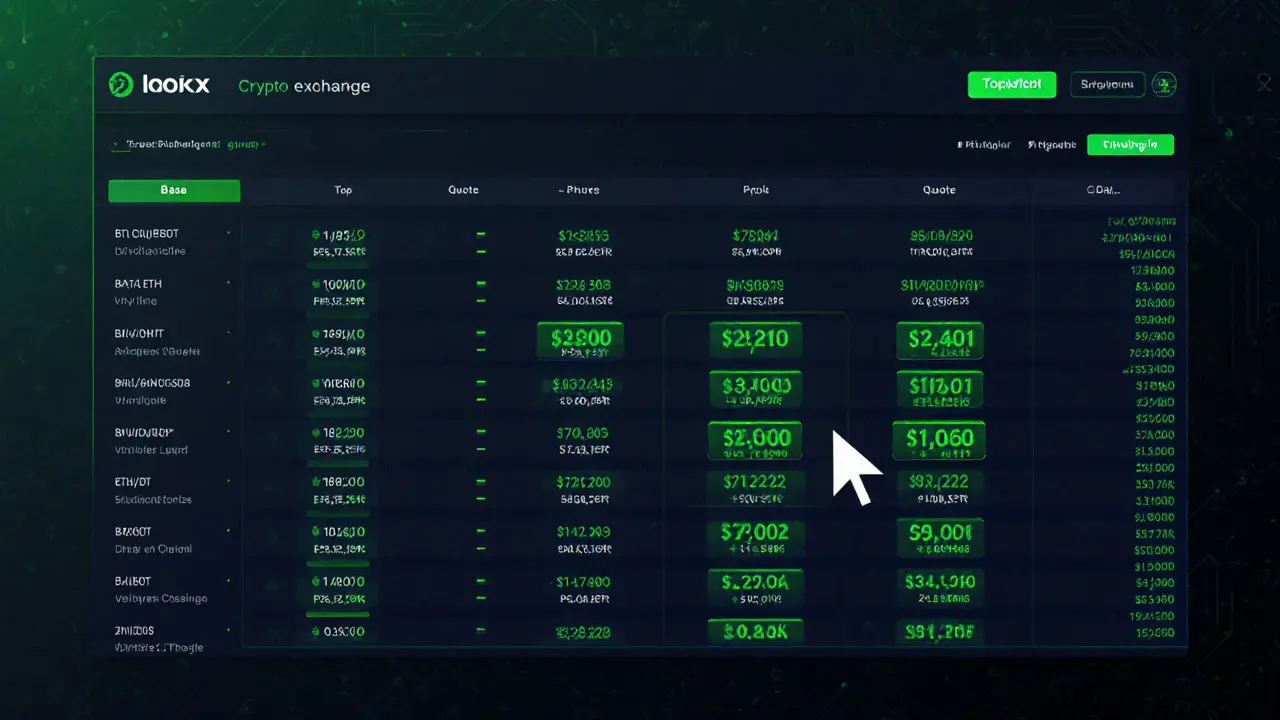How to Read Crypto Trading Pair Notation - Simple Guide for Beginners
 Oct, 20 2025
Oct, 20 2025
Trading Pair Converter
Calculate how much of the quote currency you need to buy a specific amount of the base currency, or how much base you get for a given amount of quote currency. This tool demonstrates the relationship explained in the article.
How This Works
In crypto trading pairs like BTC/USDT, the price shows how many units of the quote currency (USDT) you need to buy 1 unit of the base currency (BTC). For example, if BTC/USDT = 31,200, it means 1 BTC costs 31,200 USDT.
Remember: When you see BASE/QUOTE, the price tells you how many QUOTE tokens you need for one BASE token. The reverse (QUOTE/BASE) shows how many BASE tokens you get for one QUOTE token.
Conversion Result
Understanding Your Result
1 =
This means you need to buy .
Common Use Cases
If price = 31,200 USDT/BTC, then 1 BTC = 31,200 USDT
If price = 0.000032 USDT/BTC, then 1 USDT = 0.000032 BTC
When you see a Crypto Trading Pair is a standardized notation that shows the relative value of two digital assets, usually a cryptocurrency against another cryptocurrency or a stablecoin, you’re looking at the price relationship between two assets.
What a Trading Pair Actually Represents
Every trading pair consists of two parts: the Base Currency is the first token in the pair - it’s what you are buying or selling, and the Quote Currency is the second token - it’s the asset you use to pay for the base. In the pair ETH/BTC, Ethereum (ETH) is the base, Bitcoin (BTC) is the quote, and the displayed price tells you how many BTC you need for one ETH.
Common Ticker Symbols You’ll Encounter
Most exchanges stick to a short, three‑ or four‑letter ticker for each asset. Some of the most frequent symbols include:
- Bitcoin (BTC) - the original cryptocurrency (Kraken calls it XBT in some APIs)
- Ethereum (ETH) - the leading smart‑contract platform
- Tether (USDT) - the most‑used stablecoin, pegged to the US dollar
- USDC - another dollar‑pegged stablecoin, favored by institutional traders
- DAI - a decentralized stablecoin popular on DEXs
Reading the BASE/QUOTE Format
The slash (/) works like a division sign in math: BASE/QUOTE = BASE ÷ QUOTE. The price you see is the amount of quote currency required to purchase one unit of the base currency. For example, a price of 31,200 USDT on the BTC/USDT pair means that one Bitcoin costs 31,200 USDT.
If the order is reversed - USDT/BTC - the number shown is how many Bitcoins you receive for one USDT, which is a tiny fraction (around 0.000032 BTC at the same market level). Most exchanges default to the BASE/QUOTE convention, but a few platforms display the opposite perspective, so always double‑check the column headers.

Typical Pairs and When to Use Them
New traders should start with high‑liquidity pairs because they have tighter spreads and less slippage. The most popular pairs as of 2025 are:
| Pair | Base | Quote | Typical Use |
|---|---|---|---|
| BTC/USDT | Bitcoin (BTC) | Tether (USDT) | Core store of value, high volume |
| ETH/USDT | Ethereum (ETH) | Tether (USDT) | DeFi & NFT exposure |
| BNB/USDT | Binance Coin (BNB) | Tether (USDT) | Exchange ecosystem token |
| BTC/ETH | Bitcoin (BTC) | Ethereum (ETH) | Cross‑asset arbitrage |
| DAI/USDC | DAI | USDC | Stablecoin arbitrage on DEXs |
Common Mistakes and How to Avoid Them
Novice traders often flip base and quote, leading to unintended position sizes. A Reddit post from early 2024 highlighted a $127 loss when the author thought BTC/USDT meant “how many USDT I get for selling BTC” instead of “how many USDT I need to buy BTC”.
Here are three quick checks:
- Read the column header: “Price (Quote per Base)”.
- Verify the direction on the trade ticket - most platforms explicitly label “Buy Base with Quote”.
- Use a small test order (e.g., $10) before committing larger capital.
How Major Exchanges Display Pairs
While the underlying notation is the same, UI details differ:
- Binance shows the price as “BTC/USDT - 31,200” and a tooltip that reads “1 BTC = 31,200 USDT”.
- Coinbase labels the same view “BTC‑USDT” and adds a “Market price” tag underneath.
- Kraken historically used “XBT/USD” in its API, which can confuse users accustomed to “BTC/USDT”.
- Gemini recently introduced a dual‑notation toggle that displays both BASE/QUOTE and QUOTE/BASE side‑by‑side, reducing errors by 27% in pilot tests.
When you switch platforms, pause and glance at the pair description to confirm the direction.
Advanced Notation: Cross‑Chain and Futures
Beyond spot trading, futures contracts and cross‑chain swaps add extra layers. A futures ticker often follows PRODUCTCODE_BASEQUOTE_EXPIRY, for example BTCUSD_20251231. The BASEQUOTE part still respects the standard BASE/QUOTE order.
Cross‑chain protocols like Thorchain use a dot notation to show the originating chain: BTC.BTC/ETH.USDC means “native Bitcoin on Bitcoin chain versus Ethereum‑based USDC”. These notations are not yet universal, so limit them to platforms that explicitly support them.
Quick Checklist for Reading Any Pair
- Identify the Base and Quote currencies.
- Confirm the exchange’s default direction (BASE/QUOTE or reversed).
- Read the price column label.
- Make a tiny test trade to verify the logic.
- Check liquidity - high‑volume pairs have tighter spreads.
Next Steps: Practice Makes Perfect
Start with the "big three" pairs - BTC/USDT, ETH/USDT, and BNB/USDT - on a demo account. Track how the price changes when the market moves and note the quote amount required for one base unit. After a few sessions, try a less‑liquid pair like XRP/BTC to feel the impact of slippage.
Why does the slash mean "per" in a trading pair?
Mathematically a slash denotes division. In BASE/QUOTE you’re dividing the base amount by the quote amount, so the price tells you how many quote tokens you need for one base token.
Is BTC/USDT the same as USDT/BTC?
They are reciprocal. BTC/USDT shows the price of one Bitcoin in USDT. USDT/BTC shows how many Bitcoins you get for one USDT, which is simply 1 divided by the BTC/USDT price.
What’s the safest pair for a beginner?
High‑liquidity stablecoin pairs like BTC/USDT or ETH/USDT are ideal. They have tight spreads, abundant market data, and minimal slippage.
How do I know if an exchange uses dual notation?
Platforms like Gemini now offer a toggle in the chart view that displays both BASE/QUOTE and QUOTE/BASE. Look for settings labeled “Pair Notation” or “Display Mode”.
Can I trade cross‑chain pairs directly?
Only on DEXs that support cross‑chain bridges, such as Thorchain. The notation will include the source chain (e.g., BTC.BTC/ETH.USDC) and you’ll need to connect wallets on both chains.


Scott McCalman
October 20, 2025 AT 09:24If you ever mix up the base and quote, you’ll end up buying the opposite of what you thought – and trust me, that feels like a gut‑punch 🤕. Double‑check the column header before you click “Buy”, because the price column always reads “Quote per Base”. A quick glance at the pair description can save you a nasty surprise. Don’t let a simple slip ruin your day!
Elizabeth Chatwood
October 24, 2025 AT 07:50Yo keep your eye on the ticker and you’ll avoid the classic base‑quote flip mistake. It’s super easy once you get the habit – just glance at the pair label and you’re good to go! Keep hustlin and don’t let a tiny typo cost you cash
Tom Grimes
October 28, 2025 AT 06:17When you first see a crypto pair the format can look confusing at first.
The slash simply separates the base from the quote.
The base is the coin you want to trade.
The quote is the coin you use to pay.
For example BTC/USDT means you are buying Bitcoin with Tether.
If you see USDT/BTC the direction is reversed and you are buying Tether with Bitcoin.
Many beginners forget this and place orders the wrong way.
That mistake often shows up as an unexpected loss.
The price column on most exchanges is labeled “quote per base”.
Always read that label before you enter a trade.
A quick test order of a few dollars can confirm the direction.
High‑liquidity pairs like BTC/USDT have tighter spreads and are safer for practice.
Low‑liquidity pairs may have wild price swings and higher slippage.
Some platforms like Gemini even offer a toggle to show both notations side by side.
Using the toggle can reduce errors dramatically.
Take the time to get comfortable with the notation and you’ll trade with far less stress.
Paul Barnes
November 1, 2025 AT 04:44Honestly, if the UI flips the pair you’re probably reading it wrong.
John Lee
November 5, 2025 AT 03:10Imagine stepping into a bustling market where every stall shouts its price in a different language – that’s what crypto pairs can feel like. The key is to learn the alphabet of the market: base, quote, slash, and the direction. Once you can read the signs, the chaos turns into a rhythm you can dance to. 🎶
Jireh Edemeka
November 9, 2025 AT 01:37Oh sure, because every trader loves a little surprise when their “BTC/USDT” order actually buys USDT with BTC – what a thrilling way to learn the ropes. 🙄
del allen
November 13, 2025 AT 00:04Hey, don’t stress too much! Everyone screws up the base‑quote thing at first – just double‑check the pair label and you’ll be fine 🙂
Tiffany Amspacher
November 16, 2025 AT 22:30In the grand theater of finance, the slash is the curtain that separates the hero from the side‑kick – miss it and the plot twists against you.
James Williams, III
November 20, 2025 AT 20:57From a technical standpoint, the BASE/QUOTE notation is essentially a price ratio, where the numerator is the asset you’re acquiring and the denominator is the settlement asset. Spot markets standardize on this to ensure price feeds align across order books. If you’re pulling data via the Binance API, you’ll see “symbol”: “BTCUSDT” and the price reflects USDT per BTC.